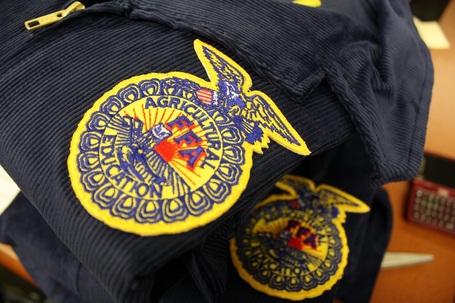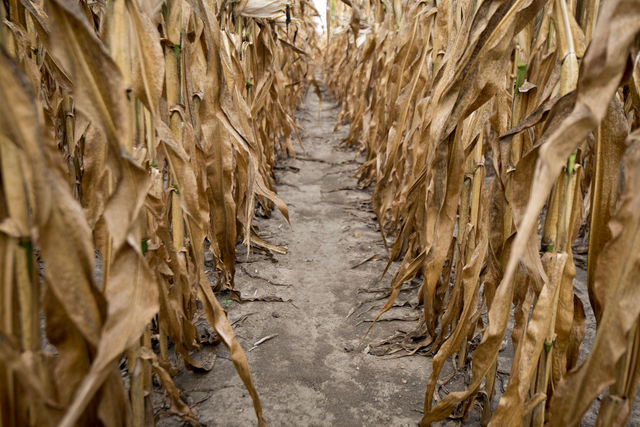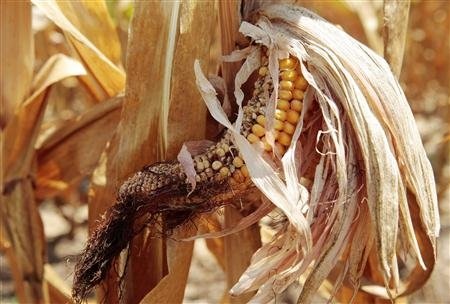The FFA Jacket, adopted in 1933 as part of the “official dress” for the National FFA Organization, is nearing is 80th anniversary. This jacket means a lot too many present and former members of the National FFA Organization. The FFA jacket means a lot to me, as an FFA member, because of all the memories and friends I have made wearing it. So, where did this very unique blue corduroy jacket and its design come from?
The Story Behind the FFA Jacket
One day a man named Gus Litner, an advisor of the Fredericktown FFA Chapter, saw a blue corduroy jacket with a bulldog on the back of it at a hardware store. He thought the jacket would be perfect for his FFA band members to wear as they performed at National FFA Convention. He talked to the owner of the hardware store and was informed about the Universal Uniform Company in Van Wert, Ohio, where the corduroy jacket was made. Mr. Litner bought a few of the jackets and had the back of them designed to have an FFA emblem and the name of his FFA chapter in gold thread. The band members of the Fredericktown FFA Chapter wore the jackets while they performed at National FFA Convention in Kansas City, Missouri. The jacket caught the attention of all who saw it that day. The members of the National FFA Organization liked the jacket design so much that they adopted it as part of the “official dress” in 1933.
Differences in Jackets from Then and from Now
There is however a few differences in the old FFA Jackets and the new ones we wear today. The vintage ones had snaps not zippers. The emblems were embroidered, not patches. The pockets were square rather than rounded. The wording on the emblem said “Vocational Agriculture” rather than “Agricultural Education”.
I will never forget when I got my first FFA Jacket. My Ag teacher, Mrs. Pike, helped me order my jacket. When it came in she gave me a small piece of paper. (I strongly encourage everyone to do this when they get their first jacket.) The paper said to list three goals for yourself as an FFA member. On the sheet I listed: 1.Compete at National FFA Convention, 2.Become a District Officer, and 3.Apply for a Proficiency Award. Completing all three of the goals I set when I got my jacket as an eighth grader was a great moment for me. I recently got a new FFA Jacket for becoming Central District President of the Alabama FFA Association, and I was super excited to get it. The FFA Jacket means memories, learning, growth, and friendships to me. What does the FFA Jacket mean to you?
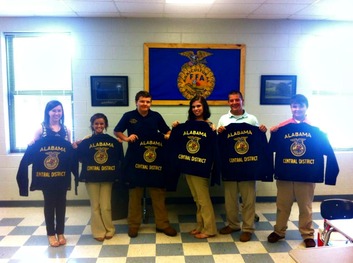
2013-2014 Alabama FFA Central District Officers
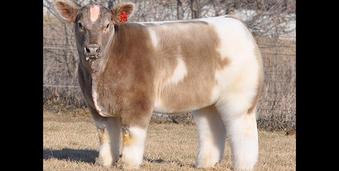 "Texas Tornado" "Texas Tornado" Towards the end of May "fluffy cows" became "viral" when a photo of a show steer (Texas Tornado) from Lautner Farms was posted on the internet . It even trended on Twitter this week using the hashtag #fluffycows. What is a "fluffy cow" anyways? A "fluffy cow" is a cow, bull, or calf that has been groomed for a show to appear fluffy and appealing. To create the look of the "fluffy cow" farmers, ranchers, FFA members, and 4-H members can spend around two hours or more grooming their cattle. They wash, clip, apply special oils to make the coat appear soft, blow dry, and hairspray the cattle. Showing cattle teaches children to be smart, hardworking individuals and the importance of animal care and agriculture. They learn many beneficial things all while having fun in the show ring. These cows are also proof of the care and commitment that it takes to be a farmer or rancher.
These "fluffy cows", however, are forming a debate about the publicity the beef industry is getting from them. Some believe this is bringing positive publicity to the beef industry by creating an open door to opportunities to describe how the beef industry really works and how important beef production and showing cattle can be. Whereas, others believe this is bringing negative publicity and that it may not be to the best interest of the beef industry to have "beef" portrayed as "cute, fluffy, and too adorable to eat."
As AGvocates, we need to use the publicity agriculture and the beef industry is getting from "fluffy cows" to make sure consumers do not come to the wrong assumption that these cattle are "too cute to eat."
Please share this article with your friends! Also, answer our poll below after reading the article.
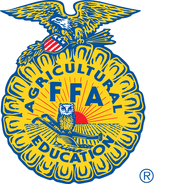 The 85th Alabama FFA State Convention took place Tuesday, June 4th through Friday, June 7th. There were over 1,700 members and guests in attendance at this year's convention and I was very fortunate to be one of them. On Tuesday, June 4th, members competed in many different Career Development Events (CDEs) which were held in Auburn, AL at Auburn High School. Wednesday, June 5th through Friday, June 7th, the actual convention was held at the Renaissance Hotel in Montgomery, AL.
Wednesday, June 5th, many FFA members, including myself, were able to participate in the FFA's nationwide service project, The Rally to Fight Hunger. The Rally to Fight Hunger is a service project in which the FFA partnered with Kids Against Hunger to package meals to be sent to food banks across the state. The Alabama FFA surpassed its goal of packaging 40,000 meals. This is an outstanding accomplishment!
The opening session of the convention was held Wednesday, June 5th at 2 p.m. During the session members were inspired to "Look on the 'Right' Side" by keynote speaker Derrick Tennant. The second session of the convention began at 7 p.m. the same night. During this session Nikki Giba, Alabama FFA State Sentinel, and Dawn Turner, Alabama FFA Vice-President gave their retiring addresses.
During the third session on Thursday, June 6th at 8:30 a.m., CDE Awards were announced. Those teams and individuals placing first in CDEs will advance to compete at National FFA Convention in Louisville, KY in October of this year. Also during this session, Abby Himburg, Alabama FFA State Treasurer, and Lucinda Daughtry, Alabama FFA State Secretary, gave their retiring addresses. That night at 7:30 p.m. the fourth session took place. During the fourth session many Agricultural Proficiency Awards were received. I was awarded 4th place in the Agricultural Communications Proficiency Award area for this blog! Luke Knight, Alabama FFA State Reporter, gave his retiring address and Wiley Bailey, National FFA Officer, gave an inspiring keynote address.
The final session took place Friday, June 7th at 8:30 a.m.. During the final session the State FFA Degree Ceremony took place with over 200 Alabama FFA members receiving their State FFA Degree. Also during this session, Josh Williams, Alabama FFA State President, gave his retiring address and the 2013-2014 Alabama State FFA Officers were elected. The 2013-2014 Alabama FFA State Officers are: William Norris (Wetumpka) - President, Bailey Sims (Marbury) - Vice President, Hayden Whittle (Geneva) - Secretary, Shelby Windham (Ariton) - Treasurer, Kelsey Faulkner (Ardmore) - Reporter, and Alyssa Hutcheson (Red Bay) - Sentinel. Convention was adjourned with the final tap of the gavel by the newly elected Alabama FFA State Officers. Over 1,700 members and guests greatly enjoyed this year's convention. Thank you Alabama FFA for another memorable and fun-filled state convention!
As we all know this year has been a tough year for farming in our country due to crops having to undergo many harsh situations. The amount of crops in the United States and other places in North American have been low due to record breaking heat, severe drought, wildfires, and hurricane effects. While mostly missing the fall harvest, Hurricane Sandy still left a negative effect on crops in eastern North America. Sandy’s rough winds and flooding rains damaged crops along its 2,000 mile path. The major damage was done to some urban farms in New York City. Sandy started in the Caribbean causing many deaths and destruction of agricultural land. Much of this destruction was in Haiti, where flooding rains and landslides wiped out roads and farmland. Most of the crops in Haiti that survived Hurricane Issac were destroyed during Sandy. Food security may even be an issue in Haiti due to Hurricane Sandy. Cuba was also negatively affected by Sandy. Many of the country’s coffee farms were destroyed overnight. It is possible that Cuba may produce its lowest output in coffee beans in more than a century. Crops such as bananas, tomatoes, and watermelons were lost in the Bahamas. Localized crop damage in New York City has been severe due to seawater flooding. Many rooftop gardens escaped the flooding but some plants did not. Some of the farm raised bees in New York City also got washed away. I wish the best to all of those affected by Hurricane Sandy and they will be continued to be remembered in my prayers. If you would like to learn more about the effects of Hurricane Sandy please visit http://en.wikipedia.org/wiki/Hurricane_Sandy. To help the victims of Hurricane Sandy please visit the sites below: http://www.samaritanspurse.org/index.php/articles/hurricane_sandy/ http://www.billygraham.org/crisisresponse
What is the “farm bill”?
The Farm bill is a statute that can regulate farm production and prices. It creates jobs, protects our environments and natural resources, revitalizes rural economies, invests in education, promotes renewable energy, and improves public health and nutrition.
The bill does not just benefit farmers, it benefits everyone. It provides funds to grow, promote, and purchase safe and healthy foods. In the long run it benefits each and every one of us; whether we know it or not. The farm bill offers many programs that are designed to help farmers during the current drought crisis. The drought is causing farmers’ crops across the nation to dry out and die. However, if the bill does not pass soon farmers could lose a lot of hard earned money. I think right now we really need a temporary drought relief package to help out farmers losing crops and money due to what is possibly the worst drought in 50 years. There is expected to see a drop in bushels of corn produced as compared to last year, even though farmers have planted more this year than any time in the past 75 years. The longer it takes to pass this bill, the more money we are losing.
One of the problems we are facing is that farmers need to plan, just as any other business and industry does. They need to know what their future is going to hold. They cannot know this without a lot of the programs, policies, etc. that is included in the farm bill. A lot of the debate is being focused on food assistance programs for the poor, which makes up for a lot of the bill’s spending. If we rush to pass this bill it should not be at the expense of jobs and struggling families, especially because it could take away from school lunches, which is sometimes the only meal that kids from these struggling families may receive each day.
It has been expected that little will happen between now and the presidential election (November 6th). However, I feel that there will be a push to pass something disaster related in September because of the severity of the drought. Hopefully seeing the conditions the drought is causing across the country congress will act soon. We are simply running out of time to pass this bill.
Wednesday, the United States Department of Agriculture reported half of the nation’s counties have been declared “natural disaster areas” because of severe droughts affecting the West, Midwest, and Southeast. About 1,584 counties across 32 states are experiencing the drought. Some are saying this is the worst drought in more than 50 years. The drought is shriveling a lot of food crops & animal feedstock in the affected counties. With the drought continuing and crop shortages, this means higher food prices are to be expected. The USDA estimates that prices could rise as much as 3.5 percent this year and up to 4 percent in 2013. The USDA said it was allowing haying and grazing on 3.8 million protected acres and that insurance companies agreed to a 30 day grace period for farmers on insurance premiums. The Nature Conservancy was okay with the haying and grazing, as long as the impacts to wildlife and habitats were minimal. These are a few steps that the USDA and others are taking to help farmers in drought areas. Corn and soybean ratings are also tremendously decreasing, and are in the worst shape for this time of year since 1988. About 24 percent of the corn was in good or excellent condition and an estimated 29 percent of the soybean crop with top ratings, both of these as of last week. The corn crop has received most of the damage. Everyone is hoping for rain. It will most likely not save the corn crop, but could probably limit the damage of the soybean crop. To find out more about the drought and to remain updated visit the following website: http://droughtmonitor.unl.edu/
|
